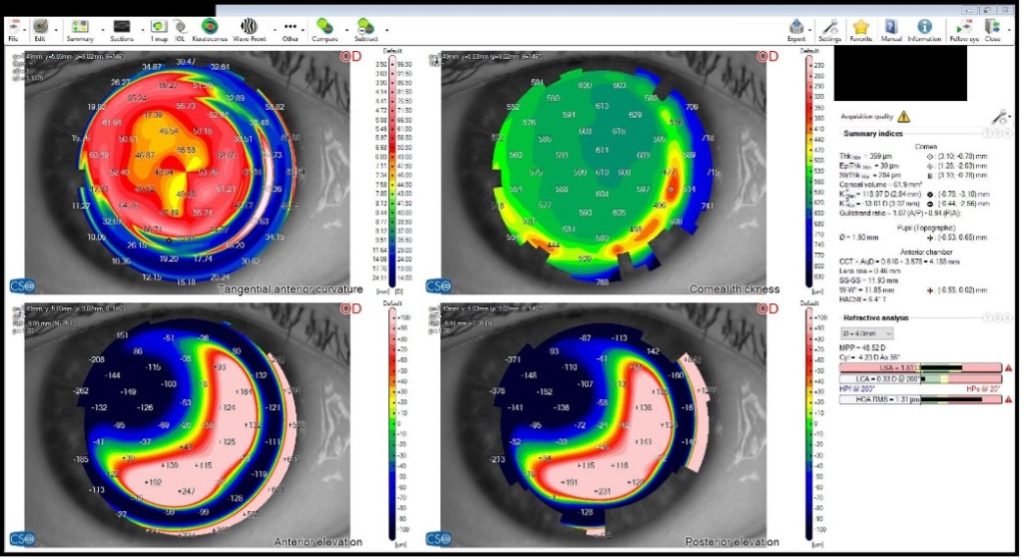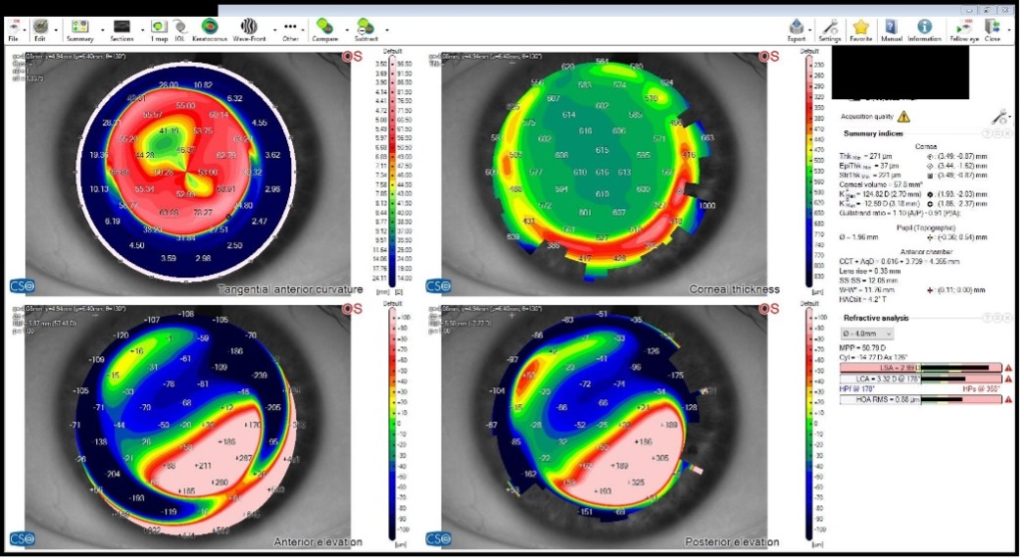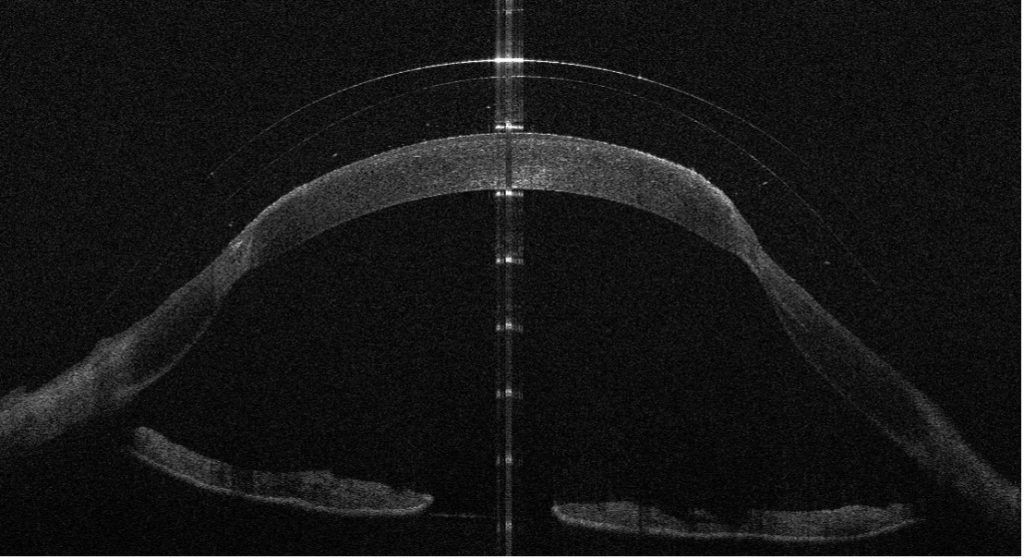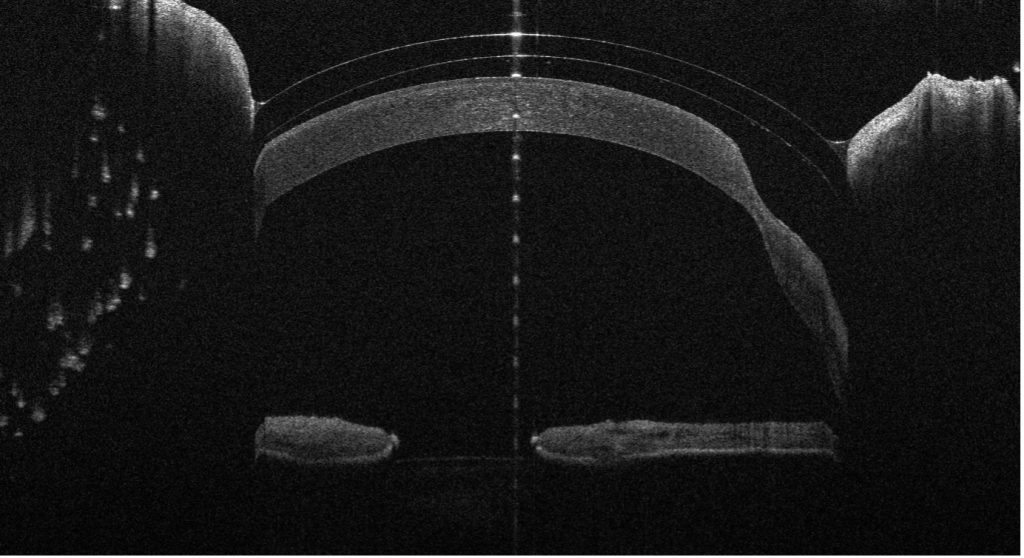Managing Bilateral Penetrating Keratoplasty-Related Rim Ectasia and Astigmatism
Introduction
This patient is a 51 YO female who had bilateral Penetrating Keratoplasties around 30 years ago in Rotterdam. Her grafts have become ectatic over the years and now exhibit signs of Rim Ectasia. This presents itself as a thinning of the host cornea leading to a tilting of the graft and a significant increase in irregular astigmatism.

Right Topography

Left Topography
Her current spectacle prescription is:
R -2.50/-6.50×50 6/7.5
L +1.25/-12.75×125 6/7.5-
Her visual acuity with the spectacles is good but her occupation as a Paediatric Doctor means her glasses are an inconvenience and after seeing the Corneal Consultant, she was referred to me for a contact lens fitting. The amount of irregular astigmatism and the fact that the grafts are tilted forward superiorly means that even in a post-graft design, corneal GPs would be unsuitable. After a discussion with the patient, we decided to fit some mini-sclerals. The patient had previously worn full 22mm sclerals in the past and was receptive to the idea of mini-sclerals.
Initial fitting appointment 16/4/21
Trial with OneFit Med, Blanchard laboratory, Canada
Several lenses were trialled before a pair of lenses were found which cleared the cornea in both eyes.
The image below shows one of the lenses trialled with excessive clearance over the whole cornea, which illustrates the extent of the Rim Ectasia in this patient.

Finally, the 5450μ lens for the RE and the 5750μ for the LE were used.
| Right Eye | Left Eye | |
| Lens | 5450 μ sag -10.00 toric periphery 150 μ | 5750 μ sag -11.00 toric periphery 150 μ |
| O/R | -2.50/-1.50×120 | -4.00/-1.50×40 |
| V/A | 6/7.6++ | 6/6- |
The lenses were allowed to settle for 40 minutes before over-refraction and then OCT scanning was conducted using the MS-39 AS-OCT from CSO Italia, which produces a 16mm image size and can image the full diameter of the lens in situ.
The OCT images showed central clearance of R 175 μ and L 200 μ however there was a significant amount of touch in the 12 O’clock position on both eyes L>R.
The flat axes of the toric periphery aligned with the corneal astigmatism at R 120 and L 40 and were tight along these axes.
The lenses required an increased height at the areas of superior touch; with the OneFit Med this is achievable in two zones at 9.5mm and 12.5mm, the clearance at 12.5 was good so the M or mid-peripheral zones height would need to be increased by 100μ in each eye. The toricity would also need increasing, using the online calculator, the new parameters were calculated as follows:
R 5450μ -10.62/-1.50×120 200μ TP M +100μ
L 5750μ -13.12/-2.50×40 200μ TP M + 100μ
It is important to keep the central clearance as low as possible to maximise the oxygen reaching the cornea. For this reason, the lenses were manufactured in the Optimum Infinite material with a 180 Dk to minimise the risk of both Hypoxia and possible corneal decompensation.
Collection appointment 24/5/21
| Right Eye | Left Eye | |
| Lens | 5450 -10.62/-1.50×120 | 5750 -13.12/-2.50×40 |
| VA | 6/7.6 | 6/7.6 |
| BEO | 6/6 | 6/6 |
AS-OCT showed no touch with 200μ of clearance centrally and 80μ of clearance at the M zone.

Px was then instructed on insertion and removal, issued with Hy-Care, Saline, case and instructed to build up wearing time by 1 hour/day to a maximum of 10 hours until the next visit.
Follow-up visit 21/6/21
Wearing time today: 4 hours
| Right Eye | Left Eye | |
| Lens | 5450 -10.62/-1.50×120 | 5750 -13.12/-1.50×40 |
| M | +100μ | + 100μ |
| TP | 200μ | 200μ |
| VA | 6/6- | 6/7.6 |
| OR | -1.00 | -1.00 |
| VA | -6/6 | 6/6 |
| BEO | 6/6- | 6/6- |
Scanning the patient with AS-OCT showed that the right lens had settled back and was now touching the superior cornea at approximately 2 o’clock slightly inside the central zone of the lens and caused some edge lift off superiorly.
Some increase in superior clearance was required without increasing the central clearance due to Hypoxia concerns with a thick fluid layer over the graft. The OneFit has a reverse geometry option called Central Clearance Reduction (CCR). This flattens the base curve of the optic zone diameter. In this instance, by using CCR, the flatter base curve lifts the lens away from the protruding graft and has the additional benefit of reducing some of the high minus in the lens power.
The calculator was used to produce the new lens specification taking into account the over-refraction and CCR on the right lens.
| Right Eye | Left Eye | |
| Lens | 5450 -7.62/-1.50×120 | 5750 -14.12/-1.50×40 |
| CCR | 5450 -7.62/-1.50×120 | 5750 -14.12/-1.50×40 |
| M | +100μ | +100μ |
| TP | 200μ | 200μ |
The existing lenses were retained from the patient as it was too risky for her to keep wearing lenses with corneal touch particularly as it was near the graft/host margin.
Collection appointment 27/7/21
| Right Eye | Left Eye | |
| Lens | 5450 -7.62/-1.50×120 | 5750 -14.12/1.50×5 |
| VA | 6/6++ | 6/4.8 |
| Central Clearance | 150μ | 200μ |
| M Zone Clearance | 85μ | 125μ |
| Edges | Aligned well in both eyes; no impingement seen | Aligned well in both eyes; no impingement seen |
Edges aligned well in both eyes; no impingement seen
The Patient was again instructed to build up the wearing time gradually by 1 hour per day to a maximum of 10 hours and 4-5 days/week.
Follow-up appointment 15/9/21
| Right Eye | Left Eye | |
| Lens | 5450 -7.62/-1.50×120 | 5750 -14.12/-1.50×5 |
| VA | 6/6 | 6/6 +++ |
| Clearance | 85μ | 65μ |
| TP | 200μ | 200μ |
The patient had built up the wearing time to 5 hours per day 5 days a week which suited her working schedule. The lenses were fitting well with no adverse effects, she was put on a 3/12 recall, sooner if any issues or concerns.
Follow-up appointment 17/1/22
The patient is still happy with her lenses and is able to use them while exercising and scuba diving as well as some time at work. She finds her eyes become slightly red at about 7-8 hours so limits her time to less than that.
| Right Eye | Left Eye | |
| Lens | -7.62/-1.50×120 | 5750 -14.12/-1.50×5 |
| VA | 6/6 + | 6/4.8 |
The lenses are still clearing the cornea fully, no touch was observed in any meridian.
The corneal consultant has also seen the patient and is happy with her corneal health. She will be seen on a six-monthly review schedule in the contact lens clinic with the option for me to refer her to the corneal clinic if there are any concerns.
